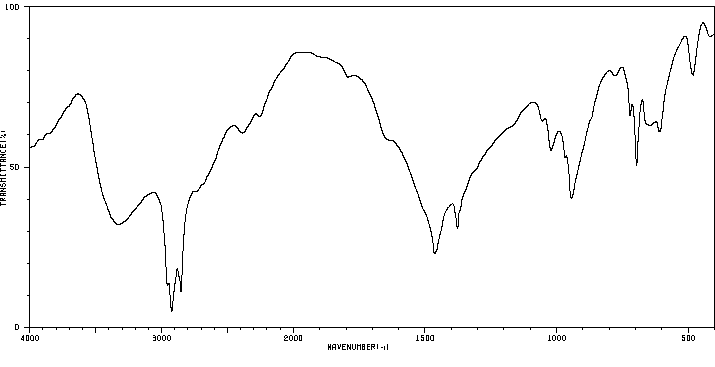乙酸铀酰 | 541-09-3
中文名称
乙酸铀酰
中文别名
醋酸氧铀;乙酸双氧铀二水合物;醋铀酰;乙酸双氧铀;乙酸铀
英文名称
UO2acet2
英文别名
uranyl diacetate;uranyl acetate;Uranylacetatdihydrat;dioxouranium(2+);diacetate
CAS
541-09-3
化学式
C4H6O6U
mdl
——
分子量
388.117
InChiKey
MCRZASGCXKHFTN-UHFFFAOYSA-L
BEILSTEIN
——
EINECS
——
-
物化性质
-
计算性质
-
ADMET
-
安全信息
-
SDS
-
制备方法与用途
-
上下游信息
-
文献信息
-
表征谱图
-
同类化合物
-
相关功能分类
-
相关结构分类
物化性质
-
熔点:110°C
-
沸点:275°C
计算性质
-
辛醇/水分配系数(LogP):-2.73
-
重原子数:11
-
可旋转键数:0
-
环数:0.0
-
sp3杂化的碳原子比例:0.5
-
拓扑面积:114
-
氢给体数:0
-
氢受体数:6
安全信息
-
危险等级:7
-
海关编码:2918300090
-
包装等级:III
-
危险类别:7
-
危险品运输编号:UN 2912
SDS
反应信息
-
作为反应物:参考文献:名称:Seisenbaeva, G. A.; Santalova, N. A.; Dunaeva, K. M., Koordinatsionnaya Khimiya, 1988, vol. 14, p. 682 - 685摘要:DOI:
-
作为产物:描述:uranyl acetate dihydrate 以 neat (no solvent) 为溶剂, 生成 乙酸铀酰参考文献:名称:Baluev, A. V.; Silin, A. Yu.; Suglobova, I. G., Radiokhimiya, 1988, vol. 30, p. 418 - 423摘要:DOI:
-
作为试剂:描述:2,3,6,7,10,11,14,15,18,19,22,23-dodecaethyl[26]hexaphyrin(0.0.0.0.0.0.0) 在 三乙胺 sodium hydroxide 、 乙酸铀酰 作用下, 以 甲醇 、 二氯甲烷 为溶剂, 反应 12.0h, 以25%的产率得到coordination of uranyl(VI) with cyclo[6]pyrrole 4参考文献:名称:Cyclo[n]pyrroles and methods thereto摘要:本发明提供一种氧化偶联程序,允许高效合成新型环[n]吡咯大环。因此,本发明提供环[n]吡咯,其中n为6、7、8、9、10、11或12,以及它们的衍生物、多聚体、异构体和离子和中性分子复合物作为新的物质组成。质子化的环[n]吡咯在电子光谱中强的Soret和Q样吸收带之间显示出高达700纳米的间隙,表明在电子光谱的可见部分没有显着的基态吸收。提供了将环[n]吡咯用作分离介质、非线性光学材料、信息存储介质和红外滤光片的用途。公开号:US20030229131A1
文献信息
-
Saccharified Uranyl Ions: Self‐Assembly of UO <sub>2</sub> <sup>2+</sup> into Trinuclear Anionic Complexes by the Coordination of Glucosamine‐Derived Schiff Bases作者:Gerrit Schaper、Marco Wenzel、Felix Hennersdorf、Leonard F. Lindoy、Jan J. WeigandDOI:10.1002/chem.202100546日期:2021.6.10ene) glucosamine (H2L2) in a similar procedure with Cs+ gave the corresponding complex [Cs(18-crown-6)]2[(UO2)3(μ3-O)(L2)3 ([Cs(18-crown-6)]22). From X-ray investigations, the [(UO2)3O(Ln)3]2− anion (n=1, 2) in each complex is a discrete trinuclear uranyl species that coordinates to the alkali metal ion via three uranyl oxygen atoms. The coordination behavior of H2L1 and H2L2 towards UO22+ was investigatedUO 2 (OAc) 2 ⋅ 2H 2 O 与生物启发配体 2-水杨基葡萄糖胺 (H 2 L 1 ) 的反应导致形成阴离子三核铀酰络合物 [(UO 2 ) 3 ( μ 3 -O) ( L 1 ) 3 ] 2− ( 1 2− ),以良好的产率分离出其铯盐,[Cs] 2 1 。 [Cs] 2 1在 18-crown-6 存在下的重结晶导致形成 [M(18-crown-6)] 2 1型中性离子对,这对于碱金属离子 Rb +也得到了和K + (M=Cs、Rb、K)。相关配体 2-(2-羟基-1-亚萘基) 葡糖胺 (H 2 L 2 ) 以与 Cs +类似的过程产生相应的配合物 [Cs(18-crown-6)] 2 [(UO 2 ) 3 ( μ 3 -O)( L 2 ) 3 ([Cs(18-冠-6)] 2 2 )。根据 X 射线研究,每个配合物中的 [(UO 2 ) 3 O( L n ) 3 ] 2−阴离子
-
Mixed-metal phosphinito complexes of platinum(<scp>II</scp>) and palladium(<scp>II</scp>) with lanthanide and actinide elements. The single-crystal X-ray structure of [UO<sub>2</sub>(OH<sub>2</sub>){(OPPh<sub>2</sub>)<sub>2</sub>Pd(S<sub>2</sub>CNEt<sub>2</sub>)}<sub>2</sub>]作者:Paul M. Veitch、James R. Allan、Alexander J. Blake、Martin SchröderDOI:10.1039/dt9870002853日期:——The single-crystal X-ray structure of the complex shows a distorted pentagonal bipyramidal uranium(VI) ion lying on a crystallographic two-fold axis with the oxo ligands of the trans-UO2 moiety, UO = 1.774(7)Å, occupying apical sites. The structure confirms co-ordination of two [(OPPh2)2Pd(S2CNEt2)]– moieties around UVI. The four phosphinito ligands bridge UVI and the two PdII centres with U–O = 2膦腈桥联的杂核络合物[M'(OPPh 2)2 M(S 2 CNR 2)} n ]的合成(M'= Ce III,Eu III,Sm III或Nd III,n = 3; M ′= Th IV,n = 4)和[UO 2(OH 2)(OPPh 2)2 M(S 2 CNR 2)} 2 ]通过[M(S 2 CNR 2)(Ph 2 PO)2 H}](M = Pd或Pt,R = Et或Pri)描述了镧系元素和act系元素的盐。[UO 2(OH 2)(OPPh 2) 2 Pd(S 2 CNEt 2)} 2 ]在单斜空间群C 2 / c中结晶,其中a = 26.285(8), b = 13.870(8), c = 21.068(6)Å,β= 90.042(8)°, Z =4。配合物的单晶X射线结构显示扭曲的五边形双锥体铀离子( VI)位于晶体学的两倍轴上,且反式-UO 2的氧代配体,U O = 1.774(7)Å,占据根尖。该结构证实了U
-
A series of Nano-sized metal ion – thiouracil complexes, tem, spectral, γ- irradiation, molecular modelingand biological studies作者:Khlood Abou- MelhaDOI:10.13005/ojc/310406日期:2015.12.30VO(II), Ni(II), Pd(II), Pt(IV) and UO2(II) complexes were prepared using H5L ligand (C21H15N9S2O3S2). All the prepared complexes are deliberately discussed using different tools(IR, Uv-Vis, 1HNMR, ESR 13CNMR, TGA, TEM, XRD).The octadentate is the main mod of ligand donation, as a neural or trinegativetowards the metal ion. This is verified using molecular modeling as a theoretical tool assert on the stereo structure of the ligand proposed leads to the donation mod. The structural formulas of the complexes were varied in between four to six coordination no. except the VO(II) complex is five. Most investigated complexes are thermally unstable due to the presence of crystal water occluded the coordinating crystal. All the spin Hamiltonian parameters as well as molecular orbital parameters were calculated for VO(II) complex. XRD patterns were investigated to calculate the particle size of each compound and display their nanosized by distinguish values. TEM scenes are also supporting the XRD data. Finally the biological activities were carried out on different bacteria as well as on fungi. The toxic effect was observed especially with Gram positive bacterium (Bacillus subtilis). Also, the effect on DNA degradation was recorded and display a complete degradation by the use of Pt(IV) and Pd(II) complexes. Whereas, a partial degradation was observed with Ni(II) and UO2(II) complexes. But, there is no effect observed with the use of ligand and VO(II) complex.使用 H5L 配体 (C21H15N9S2O3S2) 制备 VO(II)、Ni(II)、Pd(II)、Pt(IV) 和 UO2(II) 配合物。使用不同的工具(IR、Uv-Vis、1HNMR、ESR 13CNMR、TGA、TEM、XRD)对所有制备的配合物进行了仔细的讨论。八齿酸是配体供给的主要模式,作为对金属离子的神经或三负性。使用分子模型作为理论工具验证了这一点,断言所提出的配体的立体结构导致了捐赠模式。配合物的结构式在四到六个配位之间变化。除了 VO(II) 复合体是 5 之外。由于结晶水的存在封闭了配位晶体,大多数研究的配合物都是热不稳定的。计算了 VO(II) 络合物的所有自旋哈密顿参数以及分子轨道参数。研究 XRD 图案以计算每种化合物的粒径并通过区分值显示其纳米尺寸。 TEM 场景也支持 XRD 数据。最后对不同的细菌和真菌进行了生物活性研究。特别是对革兰氏阳性细菌(枯草芽孢杆菌)观察到毒性作用。此外,还记录了对 DNA 降解的影响,并显示使用 Pt(IV) 和 Pd(II) 复合物的完全降解。然而,Ni(II) 和 UO2(II) 络合物观察到部分降解。但是,使用配体和 VO(II) 络合物没有观察到效果。
-
ENZYME DIRECTED ASSEMBLY OF PARTICLE THERANOSTICS申请人:Gianneschi Nathan C.公开号:US20140193342A1公开(公告)日:2014-07-10Provided herein is a method for enzymatically triggered assembly of polymeric nanostructures for detection of cancer-associated enzymes in vivo. By detecting enzymatic signals associated with disease, one can sensitively determine the site, and extent of disease within a patient.本文提供了一种用于体内检测癌症相关酶的酶触发聚合物纳米结构组装方法。通过检测与疾病相关的酶信号,可以敏感地确定患者体内疾病的位置和程度。
-
X-Ray crystallographic and computational study on uranyl–salophen complexes bearing nitro groups作者:Arto Valkonen、Giuseppe M. Lombardo、Kari Rissanen、Francesco Punzo、Massimo CamettiDOI:10.1039/c6dt04773d日期:——In the solid state, salophen–UO2 complexes bearing one, two, or three NO2 groups lack the pronounced ligand curvature that represents a structural hallmark for this class of compounds. A detailed structural study based on single-crystal X-ray crystallography and computational methods, comprising molecular dynamics, gas-phase Hartree Fock, and DFT calculations, was carried out to investigate the coordination
表征谱图
-
氢谱1HNMR
-
质谱MS
-
碳谱13CNMR
-
红外IR
-
拉曼Raman
-
峰位数据
-
峰位匹配
-
表征信息
同类化合物
(甲基3-(二甲基氨基)-2-苯基-2H-azirene-2-羧酸乙酯)
(±)-盐酸氯吡格雷
(±)-丙酰肉碱氯化物
(d(CH2)51,Tyr(Me)2,Arg8)-血管加压素
(S)-(+)-α-氨基-4-羧基-2-甲基苯乙酸
(S)-阿拉考特盐酸盐
(S)-赖诺普利-d5钠
(S)-2-氨基-5-氧代己酸,氢溴酸盐
(S)-2-[[[(1R,2R)-2-[[[3,5-双(叔丁基)-2-羟基苯基]亚甲基]氨基]环己基]硫脲基]-N-苄基-N,3,3-三甲基丁酰胺
(S)-2-[3-[(1R,2R)-2-(二丙基氨基)环己基]硫脲基]-N-异丙基-3,3-二甲基丁酰胺
(S)-1-(4-氨基氧基乙酰胺基苄基)乙二胺四乙酸
(S)-1-[N-[3-苯基-1-[(苯基甲氧基)羰基]丙基]-L-丙氨酰基]-L-脯氨酸
(R)-乙基N-甲酰基-N-(1-苯乙基)甘氨酸
(R)-丙酰肉碱-d3氯化物
(R)-4-N-Cbz-哌嗪-2-甲酸甲酯
(R)-3-氨基-2-苄基丙酸盐酸盐
(R)-1-(3-溴-2-甲基-1-氧丙基)-L-脯氨酸
(N-[(苄氧基)羰基]丙氨酰-N〜5〜-(diaminomethylidene)鸟氨酸)
(6-氯-2-吲哚基甲基)乙酰氨基丙二酸二乙酯
(4R)-N-亚硝基噻唑烷-4-羧酸
(3R)-1-噻-4-氮杂螺[4.4]壬烷-3-羧酸
(3-硝基-1H-1,2,4-三唑-1-基)乙酸乙酯
(2S,4R)-Boc-4-环己基-吡咯烷-2-羧酸
(2S,3S,5S)-2-氨基-3-羟基-1,6-二苯己烷-5-N-氨基甲酰基-L-缬氨酸
(2S,3S)-3-((S)-1-((1-(4-氟苯基)-1H-1,2,3-三唑-4-基)-甲基氨基)-1-氧-3-(噻唑-4-基)丙-2-基氨基甲酰基)-环氧乙烷-2-羧酸
(2S)-2,6-二氨基-N-[4-(5-氟-1,3-苯并噻唑-2-基)-2-甲基苯基]己酰胺二盐酸盐
(2S)-2-氨基-N,3,3-三甲基-N-(苯甲基)丁酰胺
(2S)-2-氨基-3-甲基-N-2-吡啶基丁酰胺
(2S)-2-氨基-3,3-二甲基-N-(苯基甲基)丁酰胺,
(2S)-2-氨基-3,3-二甲基-N-2-吡啶基丁酰胺
(2S,4R)-1-((S)-2-氨基-3,3-二甲基丁酰基)-4-羟基-N-(4-(4-甲基噻唑-5-基)苄基)吡咯烷-2-甲酰胺盐酸盐
(2R,3'S)苯那普利叔丁基酯d5
(2R)-2-氨基-3,3-二甲基-N-(苯甲基)丁酰胺
(2-氯丙烯基)草酰氯
(1S,3S,5S)-2-Boc-2-氮杂双环[3.1.0]己烷-3-羧酸
(1R,5R,6R)-5-(1-乙基丙氧基)-7-氧杂双环[4.1.0]庚-3-烯-3-羧酸乙基酯
(1R,4R,5S,6R)-4-氨基-2-氧杂双环[3.1.0]己烷-4,6-二羧酸
齐特巴坦
齐德巴坦钠盐
齐墩果-12-烯-28-酸,2,3-二羟基-,苯基甲基酯,(2a,3a)-
齐墩果-12-烯-28-酸,2,3-二羟基-,羧基甲基酯,(2a,3b)-(9CI)
黄酮-8-乙酸二甲氨基乙基酯
黄荧菌素
黄体生成激素释放激素(1-6)
黄体生成激素释放激素 (1-5) 酰肼
黄体瑞林
麦醇溶蛋白
麦角硫因
麦芽聚糖六乙酸酯
麦根酸







